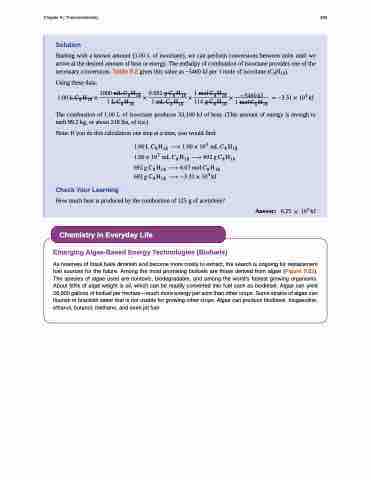Page 499 - Chemistry--atom first
P. 499
Chapter 9 | Thermochemistry 489
Solution
Starting with a known amount (1.00 L of isooctane), we can perform conversions between units until we arrive at the desired amount of heat or energy. The enthalpy of combustion of isooctane provides one of the necessary conversions. Table 9.2 gives this value as −5460 kJ per 1 mole of isooctane (C8H18).
Using these data,
���������������������� ������������ ���������� � ������� ������������ � ������ � ������� ��� ������ � ��������
The combustion of 1.00 L of isooctane produces 33,100 kJ of heat. (This amount of energy is enough to melt 99.2 kg, or about 218 lbs, of ice.)
Note: If you do this calculation one step at a time, you would find:
Check Your Learning
���������� ��������� ������� �������� ������� ����������
��������� � ������������ ��������� ������������
How much heat is produced by the combustion of 125 g of acetylene?
Answer: 6.25 � 103 kJ
Chemistry in Everyday Life
Emerging Algae-Based Energy Technologies (Biofuels)
As reserves of fossil fuels diminish and become more costly to extract, the search is ongoing for replacement fuel sources for the future. Among the most promising biofuels are those derived from algae (Figure 9.22). The species of algae used are nontoxic, biodegradable, and among the world’s fastest growing organisms. About 50% of algal weight is oil, which can be readily converted into fuel such as biodiesel. Algae can yield 26,000 gallons of biofuel per hectare—much more energy per acre than other crops. Some strains of algae can flourish in brackish water that is not usable for growing other crops. Algae can produce biodiesel, biogasoline, ethanol, butanol, methane, and even jet fuel.


